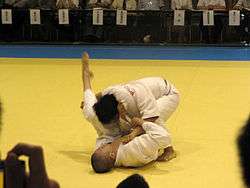Kosen judo

Kosen judo (高專柔道 Kōsen jūdō) was a refinement of Kodokan judo that was developed and flourished at the Kōtō senmon gakkō (高等専門学校) (Kōsen (高專)) technical colleges in Japan in the first half of the twentieth century. Kosen judo's competition rules allowed for greater emphasis of ne-waza (寝技, ground techniques) than in mainstream judo and it is sometimes regarded as a distinct style of judo.[1] Today, the term "Kosen judo" is frequently used to refer to the competition ruleset associated with it that allows for extended ne-waza. Such competition rules are still used in the shichitei jūdō / nanatei jūdō (七帝柔道 seven imperials judo) competitions held annually between the seven former Imperial universities.
Background

Kosen (高専 kōsen) is an abbreviation of Kōtō senmon gakkō (高等専門学校), literally 'Higher Speciality School', and refers to the Colleges of Technology in Japan that cater for students from age 15 to 20. The Kosen schools started holding inter-collegiate judo competitions from 1914.[2] The rules of a Kosen judo match were mainly Dai Nippon Butokukai and Kodokan rules prior to 1925 changes. However, the differed in that they asserted the right of competitors to enter groundwork however they wished and to remain in it as long as they wanted.[3][4] The rules allowed for a more tactical style of newaza to develop and the style was developed under the influence of judoka like Tsunetane Oda.[5] and Hajime Isogai.
Unlike mainstream Kodokan competition rules, Kosen rules allowed hikikomi (引込 pulling-in), enabling competitors to transition to newaza by dragging their opponent down without using a recognised nage-waza (analogous to pulling-guard). This was exploited by some teams that matched their less skilled students against the more skilled students of the rival teams, aiming at a draw in newaza.[4] To achieve victory under the judo rules of the time the judoka had to score ippon as there were no intermediate scores, or a draw was declared at the referee's discretion.[4]
The changes made to the mainstream Kodokan competition rules made in 1925 were largely a reaction to Kosen competition's emphasis on newaza.[2] As opposed to earlier ruleset, transition to groundwork was limited by much stricter rules and by 1929, yusei-gachi rule was introduced to end draws in matches.[2] However, Kosen schools continued to hold interscholastic competition (高專大会 kōsen taikai) tournaments with former rules.
Differently to modern judo rules leglocks were allowed (Leglocks started being prohibited by Kodokan rules in 1914 in shiai and randori as well. By 1925, even in Kosen judo, all joint-locks except elbow locks were totally prohibited together with neck cranks.).
The matches had no time limit and were usually contested on a mat 20x20 meters in total size. A starting zone 8x8 meters was marked on the mat as well as a danger zone which ended at 16x16 Meters. If a judoka went out of the danger zone the match would be restarted. If they were actively engaged in newaza the referee would call sono-mama to freeze them into position, drag them to the middle of the competition area, and call yoshi to restart the match in the same situation. This device was common in judo in general and is still part of the official Judo rules, addressed in article 18 - Sono-mama, but has since fallen into disuse, allowing modern judoka to escape newaza by going out of the competition zone.
Kosen judo style

Kosen judo, as a distinct "style" focusing training towards the Kosen ruleset, flourished in the Kyoto region until around 1940.[1] The style and the peculiar ruleset is still studied for "seven imperials judo" (七帝柔道 shichitei jūdō / nanatei jūdō) tournaments of (former) imperial universities[6] and is taught especially in Kyoto.[7] There has been a resurgence in interest in Kosen judo in recent years due to its similarities with Brazilian jiu jitsu.[8]
Bibliography
- Green, Thomas A.; Svinth, Joseph R. (2003), Martial Arts in the Modern World, Westport, CT: Praeger
- Kashiwazaki, Katsuhiko (1997), Osaekomi, Ippon Books
- Judo History Archive
References
- 1 2 Green and Svinth 2003, p282
- 1 2 3 Hoare, Syd (August 2005), Development of Judo Competition Rules (PDF), retrieved August 26, 2014
- ↑ Hoare, Syd (2009), A History of Judo, London: Yamagi books, p. 151
- 1 2 3 Kashiwazaki, Katsuhiko (1997). Osaekomi. London, UK: Ippon Books. p. 14. ISBN 1-874572-36-4.
- ↑ Okada, Toshikazu, "Master Tsunetane Oda", Judoinfo.com, retrieved August 24, 2014
- ↑ ja:七帝柔道
- ↑ Jujutsu & Newaza, Sensei St. Hilaire
- ↑ Cunningham, Steve (Fall 2002), "What is Kosen Judo?", American Judo, p. 23